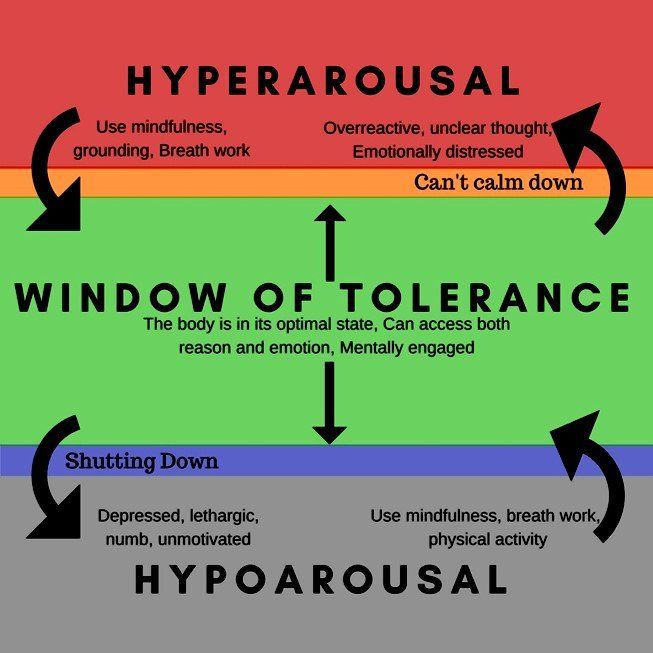THE WINDOW OF TOLERANCE
This is a concept that you may find helpful in understanding the impact of emotional dysregulation. I would like to share this with you because it is a useful concept in helping us not only understand and help our clients to manage emotional ‘overwhelm’ but can also help us to regulate our own emotional roller-coasters!
So what is it? The Window of tolerance was a term used by Dan Siegel to describe the optimal zone of arousal in which we can function most effectively. When people are within this zone, they are typically able to readily receive, process, and integrate information (i.e. learn and be creative) and otherwise respond to the demands of everyday life without much difficulty. In this zone, we can think calmly, be more rational, and are not in state of overwhelm or overloaded withdrawal.
Here’s a useful way of imagining it:
As you can see from the diagram, either side of the optimal window zone, there are other 2 states. During times of extreme stress, we can experience periods of either hyper- or hypo-arousal.
1. The Hyper-arousal zone is otherwise known as the fight/flight response. We can feel hypervigilant, or very anxious, scared or panicky. Thoughts may be racing and all the physiological symptoms of the Sympathetic Nervous System being stimulated are likely to be present (increased heart and breathing rate, dry mouth, butterflies in the stomach, shaking etc). At its most extreme, people in this zone may experience a range of symptoms associated with posttraumatic stress, such as flashbacks, nightmares an derealisation.
2. The Hypo-arousal zone is otherwise known as the freeze response. In this state, we may be emotionally numb, feel empty or at its most extreme even psychologically paralysed (‘rabbit caught in headlights’). At its most extreme, people in this zone may dissociate, have memory issues, and experience feelings of depersonalization.
In either the hyper or hypo arousal zone, we cannot process information effectively because the prefrontal cortex region of the brain goes ‘off-line’, in a manner of speaking. In contrast, the sub-cortical regions (such as the reptilian brain and the limbic system) are ‘running the show’. This is because we are in Survival Mode. This will naturally affect our ability to think rationally, and thinking can become overly rigid or chaotic. When we are in either of these zones, we are therefore out of our Window of Tolerance.
Everybody has a different range or capacity for being in their window of tolerance. People who have experienced trauma, or sustained periods of extreme stress, may find that their windows are pretty narrow. They may feel that it doesn’t take much to flip onto either Hyper or Hypo zones and it can be tricky to stay on the Window for very long.
The window of tolerance can also be affected by environment: we are generally more able to remain within the window when we feel safe and supported.
How can we manage our emotions to stay in our Windows of Tolerance?
The evidence-base indicates that a range of techniques can help an individual to get into or stay in their Window of Tolerance. These techniques help to bring ‘on-line’ the prefrontal cortex and calm down the over-activated parts of the brain (sub-cortical regions). Techniques such as grounding exercises and breath-focussed strategies can be effective ‘emotional first-aid’ strategies. Any technique that regulates and calms the breath will help. Mindfulness skills help us to remain in the present moment and are a ‘pre-fontal cortex activity’. Body-focussed therapies and apporaches such as gentle massage and yoga (if it feels safe for the individual) can also be soothing and grounding.
With regular Mindfulness practice, and for some, psychotherapeutic support, many individuals are able to widen their window of tolerance and, by doing so, increase their sense of calm and become able to deal with stress in more adaptive ways.
Further Reading:
Mindsight. By Daniel Siegel
The Mindful Therapist. By Daniel Siegel
Dr Sarah Halliday
Senior Consultant Clinical Psychologist
Halliday Quinn Limited, Nov 25 2019





